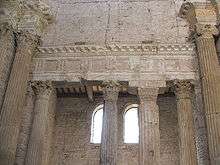Architrave

An architrave (/ˈɑːrkᵻtreɪv/; from Italian: architrave "chief beam", also called an epistyle; from Greek ἐπίστυλον epistylon "door frame") is the lintel or beam that rests on the capitals of the columns. It is an architectural element in Classical architecture.
The term can also be applied to all sides, including the vertical members, of a frame with mouldings around a door or window. The word architrave is also used to refer more generally to a style of mouldings (or other elements) framing the top of a door, window or other rectangular opening, where the horizontal "head" casing extends across the tops of the vertical side casings where the elements join (creating a butt joint, as opposed to a miter joint).[1]
Classical architecture
In an entablature in classical architecture, it is the lowest part, below the frieze and cornice. The word is derived from the Greek and Latin words arche and trabs combined together to mean "main beam". The architrave is different in the different orders. In the Tuscan, it only consists of a plain face, crowned with a fillet, and is half a module in height. In the Doric and composite, it has two faces, or fasciae; and three in the Ionic and Corinthian, in which it is 10/12 of a module high, though but half a module in the rest.[2]
Philosophical or Abstract meaning
It means the fundamental part of something (a speech, a thought or a reasoning).
The part on which the idea, the reasoning, the thought or the philosophy are based.
Examples:
1) "...the Mature Hegel- the Hegel of the Philosophy of Right- who becomes the architrave on which he (Honneth, ed.) constructs his social philosophy."
Ref.: Page: XIV, The Ethics of Democracy: A Contemporary Reading of Hegel's Philosophy of Right (Lucio Cortella, SUNY Press, 2015)LINK
2) "to become the architrave of his theoretic construction"
Ref.: Pag. 281, Economics and institutions Contributions from the History of Economic thought (Pier Francesco Asso, Luca Fiorito, Italian Association for History and Economic Thought, Vol. IV, Franco Angeli Press 2007)LINK
See also
- Archivolt — expanded and elaborated architrave element
- Dolmen — Neolithic predecessor, megalithic tombs with structural stone lintels
- Lintel
- Post and lintel — architectural system with architraves-lintels
Footnotes
- ↑ Ching, Francis D.K. (1995). A Visual Dictionary of Architecture. New York: John Wiley & Sons, Inc. pp. 179, 186. ISBN 0-471-28451-3.
- ↑
 This article incorporates text from a publication now in the public domain: Chambers, Ephraim, ed. (1728). "article name needed". Cyclopædia, or an Universal Dictionary of Arts and Sciences (first ed.). James and John Knapton, et al.
This article incorporates text from a publication now in the public domain: Chambers, Ephraim, ed. (1728). "article name needed". Cyclopædia, or an Universal Dictionary of Arts and Sciences (first ed.). James and John Knapton, et al.
External links
-
 Media related to Architraves at Wikimedia Commons
Media related to Architraves at Wikimedia Commons
